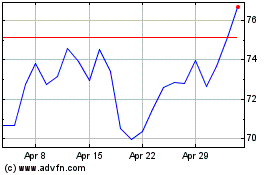Thomas A. Fanning and David Crane on their different strategies
for cleaner energy
Utilities have gone through huge dislocations and disruptions in
recent years, and big financial bets are being made as they
position themselves for energy markets of the future. Wall Street
Journal Global Energy Editor Elena Cherney talked to two key
players with divergent approaches: Thomas A. Fanning, chief
executive of Southern Co., and David Crane, who until December was
CEO of NRG Energy Inc. Edited excerpts of their conversation
follow.
MS. CHERNEY: You both took very different approaches to
transitioning to cleaner energy. David, you told me you were fired
by your board at NRG for being too radical. You also said that you
wished you had been more radical. What did you mean?
MR. CRANE: There are roughly 55 power companies in the U.S. that
produce most of the generation. In 2006, when I became very
sensitized to the carbon issue, I looked at the carbon intensities
of the 55 companies. We were 54th, or second-most carbon intense,
and the one that was ahead of us, Mirant, we ended up buying.
I went to the board and said, "Look, it's unlikely that the
world's going to allow us to [continue to] do this."
So we started on renewables. We tried to build a nuclear plant,
because I'm a big believer in nuclear as a zero-carbon source. But
I found that you had to talk about that to motivate an employee
base that wants to basically do what it has always done. So one of
the reasons I was so outspoken was to motivate the employee base,
and ultimately that made me a bit of a controversial figure.
MS. CHERNEY: Tom, you took a different approach. You described
it as a more natural evolution.
MR. FANNING: I take my management group through this exercise
from time to time where we really try to think about how much
change is out there. It is up to us, as leaders, to kind of see
around the corners.
We've moved in our energy production: Coal, before I got there,
70%; coal this year will be 28%. Gas back then was 15%, 16%; now it
is going to be about 50%. We've developed our own technology that
produces less carbon than natural gas. Renewables, we're moving
forward in a big way on solar, particularly, and some wind. Energy
efficiency, we just announced a really important acquisition,
PowerSecure International [a provider of distributed generation,
giving power customers more control over the energy they use].
The whole notion is to understand really how this model will
evolve and try to skate to where that puck will be. If you do it in
kind of a transparent, orderly way, you don't have this notion of
disruption. You have a notion of natural evolution.
MS. CHERNEY: Also, you're building a nuclear facility. Not a lot
of people are doing those things. Where do you see that mix
going?
MR. FANNING: All of the above. Nuclear, we are leading the
renaissance in new nuclear. If the country is serious about carbon,
we need nuclear in the mix. It's really hard to do nuclear. Our
deal, if you include all capital costs and all financing costs: $15
billion over 10 years. Coal, we all know that coal is under
pressure. We developed this technology where we can actually
consume coal, gasify it, capture 65% of the carbon and move on.
We've taken our lumps on that deal. That deal, probably, because
gas is so cheap right now, isn't going to happen elsewhere in the
U.S. But I'm darn sure that there's a great market for it around
the world.
MS. CHERNEY: David, can carbon capture be made to work
commercially in the U.S.?
MR. CRANE: First, Tom and Southern Co. should be commended for
what they've done with nuclear and with pre-combustion carbon
capture. But they've essentially demonstrated that those two
technologies are not cost effective. We cannot afford for
post-combustion carbon capture not to be cost effective. If we're
going to win the fight against climate change, it must succeed in
that regard when you include India and China plants. I don't think
post-combustion carbon capture, as it's done, with a technology
that's borrowed from the chemical industry, is going to get it
done.
We need a disruptive change. Overall, I would tell you that I
believe this country, the world, will win the fight against climate
change by taking the carbon out of fossil fuels before it wins the
war against climate change by making the world an all-renewable
plus battery-storage place.
MR. FANNING: Nuclear absolutely needs to be part of the
portfolio, and in the portfolio it's cost effective. Let me explain
that. The energy from our nuclear plant that we're building in
Georgia is going to be the equivalent price of about $1 per million
BTU. Now, gas is really cheap right now. The query is how long will
gas remain at that price.
Think about stock ownership as you build your own personal
portfolios. You buy some stocks that are really secure. Then you
want to have some stuff that's kind of risky and more volatile.
Maybe it's got a long-term return potential.
When you think about constructing an energy portfolio that has
got to achieve the balance of clean, safe, reliable, affordable, it
is absolutely clear. Now, there's a temporal feature here. It will
change over time. But it is a dominant solution to build nuclear --
relatively high capital cost, very cheap energy, zero volatility,
essentially.
It looks like coal is winding down. Renewables become much more
important. I've always been a fan of solar. The bridge in the
middle is gas. Every one of those has a different risk/return
profile, a different capital and energy mix, and as a portfolio,
they work.
MS. CHERNEY: David, do you agree?
MR. CRANE: In the sense that he has to get his cost basis passed
through the public service commissions of various states, arguments
like he just made about diversification of portfolio work. In the
competitive [market for energy] diversification of portfolio
doesn't necessarily work. Energy has usually been a winner-take-all
business. And right now in the U.S., the winner-take-all is natural
gas.
One of the things we should be talking about is the role the
utilities are playing in snuffing out distributed generation. The
premise [put forth by Tom] is that a central grid system is only as
strong as its weakest link. We're talking about an economy we built
in the U.S. built off 130 million wooden poles. It's shocking that
we could be this obsolete.
But every utility in the country except one, Green Mountain
Power in Vermont, is fighting the market penetration of people
making their own electricity. That's why, if you have an industry
that's based, "Oh, we're gonna give this company a monopoly and
hope that they do the right thing by the customer," that's not
going to be the best approach.
MR. FANNING: Tom and I are great friends, we really are. He's
dead wrong. Southern Co., actually our largest subsidiary, Georgia
Power, was named by the solar industry as the investor-owned
utility of the year by the solar industry. You want to buy rooftop
solar? I am glad to sell it to you.
Write to reports@wsj.com
(END) Dow Jones Newswires
April 13, 2016 02:48 ET (06:48 GMT)
Copyright (c) 2016 Dow Jones & Company, Inc.
NRG Energy (NYSE:NRG)
Historical Stock Chart
From Mar 2024 to Apr 2024

NRG Energy (NYSE:NRG)
Historical Stock Chart
From Apr 2023 to Apr 2024
